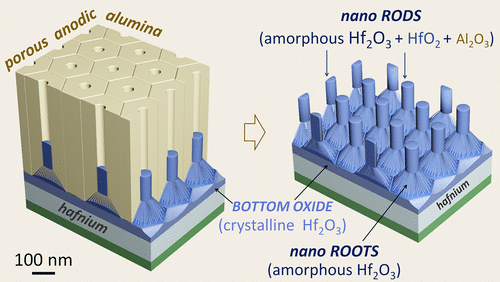当前位置:
X-MOL 学术
›
Chem. Mater.
›
论文详情
Our official English website, www.x-mol.net, welcomes your
feedback! (Note: you will need to create a separate account there.)
Hafnium-Oxide 3-D Nanofilms via the Anodizing of Al/Hf Metal Layers
Chemistry of Materials ( IF 7.2 ) Pub Date : 2018-03-29 00:00:00 , DOI: 10.1021/acs.chemmater.8b00188 Alexander Mozalev 1 , Maria Bendova 1 , Francesc Gispert-Guirado , Eduard Llobet
Chemistry of Materials ( IF 7.2 ) Pub Date : 2018-03-29 00:00:00 , DOI: 10.1021/acs.chemmater.8b00188 Alexander Mozalev 1 , Maria Bendova 1 , Francesc Gispert-Guirado , Eduard Llobet
Affiliation

|
Hafnium-oxide films with self-organized nanostructured 3-D architectures and variable dimension (10 to 400 nm) are synthesized via the high-current anodizing of thin aluminum-on-hafnium layers in phosphoric, malonic, and oxalic acid electrolytes. In the approach, the self-organized growth of a porous anodic alumina (PAA) film is immediately followed by the fast PAA-assisted reanodizing of the hafnium underlayer. The PAA-dissolved films consist of arrays of upright-standing hafnium-oxide nanorods held on the substrate by the tiny needle-like “nanoroots” widespread over a continuous hafnium-oxide bottom layer. The roots are amorphous Hf2O3, while the rods are amorphous HfO2–Hf2O3–Al2O3 mixed oxides, the bottom layer being, however, highly textured nanocrystalline HfO2. The calculated transport numbers for O2– and Hf4+(3)+ ions are, respectively, ∼0.55 and ∼0.45, which is a unique situation for anodic hafnium oxide, which normally grows by O2– transport only. Annealing the films in air at 600 °C oxidizes the remaining Hf metal to polycrystalline HfO2, still leaving the roots and rods amorphous. The annealing in vacuum results in partial oxide reduction and crystallization of the roots and rods to stable orthorhombic and monoclinic HfO2 phases. A model of the anodic film growth and solid-state ionic transport is proposed and experimentally justified. Potential applications of the 3-D hafnium-oxide nanofilms are in advanced electronic, photonic, or magnetic micro- and nanodevices.
中文翻译:

Al / Hf金属层的阳极氧化氧化3- 3-D纳米膜
通过在磷,丙二酸和草酸电解质中对-上铝薄层进行高电流阳极氧化,可以合成具有自组织纳米结构3-D结构和可变尺寸(10至400 nm)的氧化f薄膜。在该方法中,多孔阳极氧化铝(PAA)膜的自组织生长紧随其后是PA底层的快速PAA辅助再阳极氧化。溶解在PAA上的薄膜由直立的氧化ha纳米棒阵列组成,这些纳米棒由分布在连续的氧化ha底层上的细小针状“纳米根”固定在基材上。根是无定形的Hf 2 O 3,而棒是无定形的HfO 2 -Hf 2 O 3 -Al 2 O3种混合氧化物,但是底层是高度织构化的纳米晶体HfO 2。O 2–和Hf 4+(3)+离子的计算输运数分别为〜0.55和〜0.45,这对于通常仅通过O 2–输运生长的阳极氧化oxide是一种独特的情况。将薄膜在600°C的空气中退火可将剩余的Hf金属氧化为多晶HfO 2,但根和棒仍为非晶态。真空中的退火导致部分氧化物还原,并使根和棒结晶成稳定的正交晶系和单斜晶HfO 2。阶段。提出了阳极膜生长和固态离子迁移的模型,并通过实验证明了这一点。3-D氧化ha纳米薄膜的潜在应用是在先进的电子,光子或磁性微型和纳米设备中。
更新日期:2018-03-29
中文翻译:

Al / Hf金属层的阳极氧化氧化3- 3-D纳米膜
通过在磷,丙二酸和草酸电解质中对-上铝薄层进行高电流阳极氧化,可以合成具有自组织纳米结构3-D结构和可变尺寸(10至400 nm)的氧化f薄膜。在该方法中,多孔阳极氧化铝(PAA)膜的自组织生长紧随其后是PA底层的快速PAA辅助再阳极氧化。溶解在PAA上的薄膜由直立的氧化ha纳米棒阵列组成,这些纳米棒由分布在连续的氧化ha底层上的细小针状“纳米根”固定在基材上。根是无定形的Hf 2 O 3,而棒是无定形的HfO 2 -Hf 2 O 3 -Al 2 O3种混合氧化物,但是底层是高度织构化的纳米晶体HfO 2。O 2–和Hf 4+(3)+离子的计算输运数分别为〜0.55和〜0.45,这对于通常仅通过O 2–输运生长的阳极氧化oxide是一种独特的情况。将薄膜在600°C的空气中退火可将剩余的Hf金属氧化为多晶HfO 2,但根和棒仍为非晶态。真空中的退火导致部分氧化物还原,并使根和棒结晶成稳定的正交晶系和单斜晶HfO 2。阶段。提出了阳极膜生长和固态离子迁移的模型,并通过实验证明了这一点。3-D氧化ha纳米薄膜的潜在应用是在先进的电子,光子或磁性微型和纳米设备中。











































 京公网安备 11010802027423号
京公网安备 11010802027423号